Oviraptorosauria, a group of well known dinosaurs that everyone’s aware of but few people count among their favorites. Personally I’ve been in love with the group since childhood, when I first gazed upon an Oviraptor in “Dougal Dixon’s Dinosaurs”. That illustration left quite an impression; here you had this menacing, scaly, lithe predator stealing an egg under the cover of darkness. Yolk drips from its beak, its eyes glowing as if caught unawares in the headlights of some Cretaceous vehicle, out on safari along some dusty back road. I haven’t seen the image in at least 20 years but it was powerful enough that’s it has been burned in my mind ever since.
This was of course the Oviraptor of the 90’s and few dinosaurs have gone through as dramatic a makeover in the subsequent years as Oviraptor and its kin. Although companies like Papo still promote this outdated image we of course know that these dinosaurs were fully feathered nurturing parents, no doubt living in flocks and just as likely feeding on seeds and insects as they were eggs. No longer are the oviraptorosauria a group of marauding bipedal lizards, but rather gregarious, and probably handsome stem-birds, I still love them.
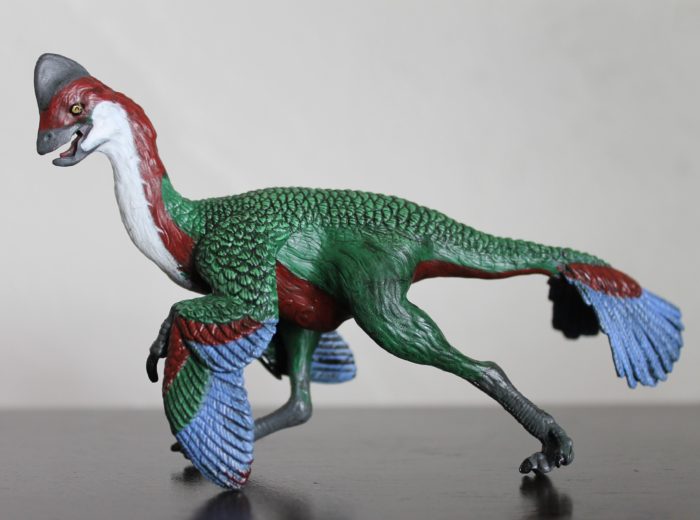
New members to the oviraptorosaur clade are added often. Most aren’t received with much fanfare unless they’re really big, or are at least given a cool name. Enter Anzu wyliei, an 11′ long, 66 million year old resident of western North America. Named in 2014 it garnered a bit of press due to the name it received which translates as “feathered demon”. The media ran with the “Hell chicken” and apparently its brief time in the spotlight was enough to warrant a figure of the creature, and new for 2018 here we have Safari’s version of Anzu wyliei.
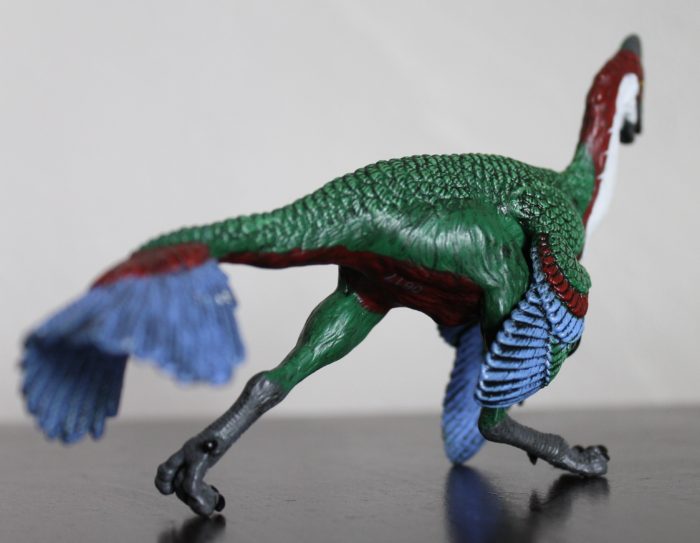
The Safari Anzu is a small and delicate looking model. It only measures just over 5” in length and stands 3.32” tall. Despite this small size this is a very well detailed little model. It’s appropriately bird-like with a full array of individually sculpted feathers. A downy mane extends down the neck, underside, and legs. The winged forearms are exquisitely sculpted with feathers appropriately anchored along the middle digit. A decorative fan of feathers adorns the tail and individually sculpted feathered are etched along the back. No spot is neglected on this animal. Even the insides of the wings and underside of the tail are spot-on.

Praise aside, the way the feathers along the back are sculpted, in a uniform pattern with green paint, they give the illusion of overlapping scales. They’re not of course, but that’s just the vibe I get when I look at them. Feathers elsewhere on the body (wings and tails not withstanding) are wispy and soft looking, the two feather types contrast sharply and I have to wonder if a more gradual blending of the two would have helped.
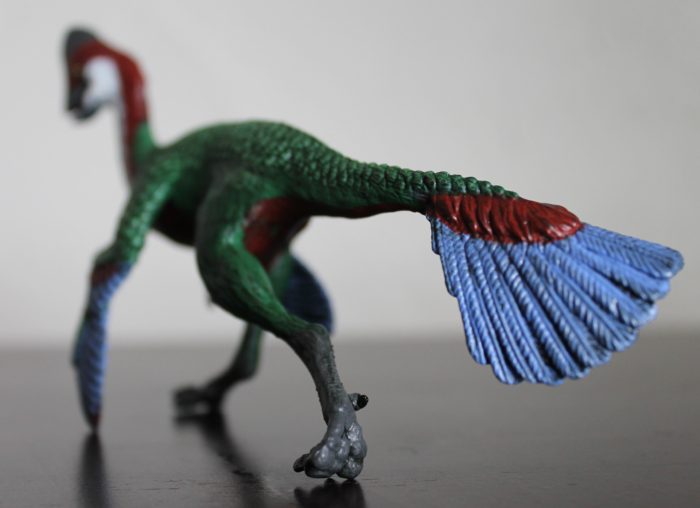
Okay, so at this point I think we can establish that this is a good oviraptorosaur figure. But is it a good Anzu figure? As with any oviraptorosaur (like ceratopsians) it’s the head that will make Anzu stand out in a crowd. In the case of Anzu we have a very tall and deep skull, with a steep crest that merges closely to the tip of the beak. Safari’s sculpt matches closely with this description, and the fossil material we have for the genus. In other respects it matches the basic oviraptorosaur body plan. Long slender arms and legs, short tail, etc. It looks like a large flightless bird, as an oviraptorosaur should.
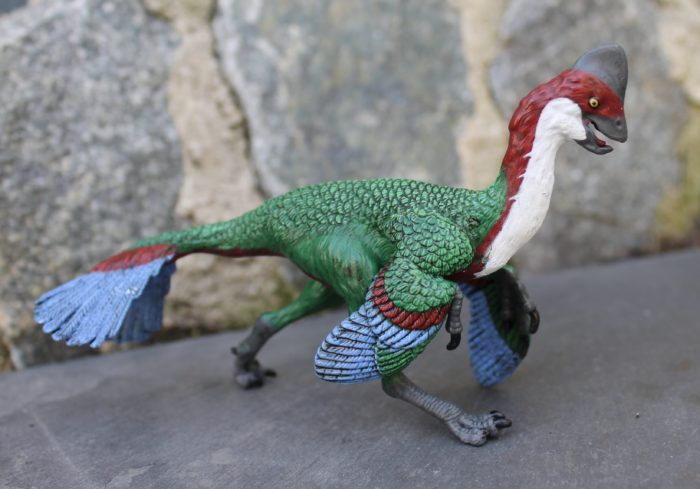
Like so many other feathered dinosaur toys this model relies on it’s wingtips to create a tripod. It’s well executed here with only the very tip of the wing resting on the ground. The animal is sculpted in a walking position, taking a long stride forward, only the very tips of the left toes pushing it forward. The beak is slightly open, the animal looking towards the left, the tail swayed slightly towards the right. It looks like an active, agile, and alert animal. The thin legs spaced far apart do create some stability problems, with the legs prone to warping.
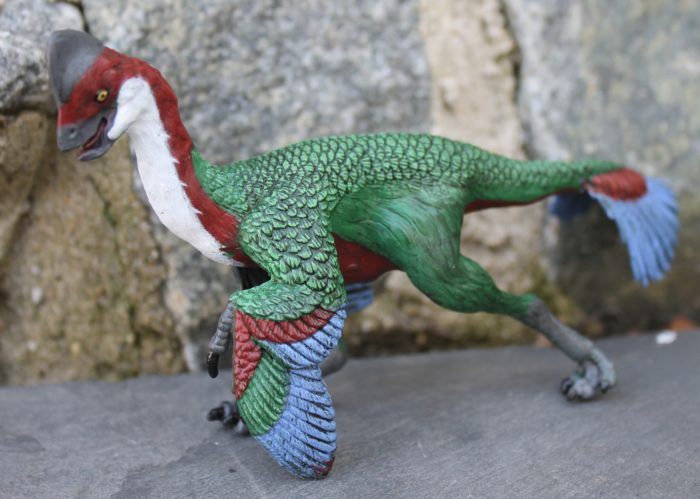
The colors presented on the toy are bold and eye catching, but realistic for what was probably a showy animal. The body’s primary color as mentioned before is green. The head, neck, and underside of the body and tail painted maroon. The lower jaw, cheeks, and underside of the neck are white. On the wings the primaries and secondary feathers are blue, the secondary coverts red, and primary coverts green. The tail feathers are red and blue, legs and hands grey, and claws black. The eyes are yellow with black pupils and they even managed to paint a pink tongue within the narrow gap of the open beak. The crest, which I would prefer to be brightly colored, is grey, as is the beak itself.
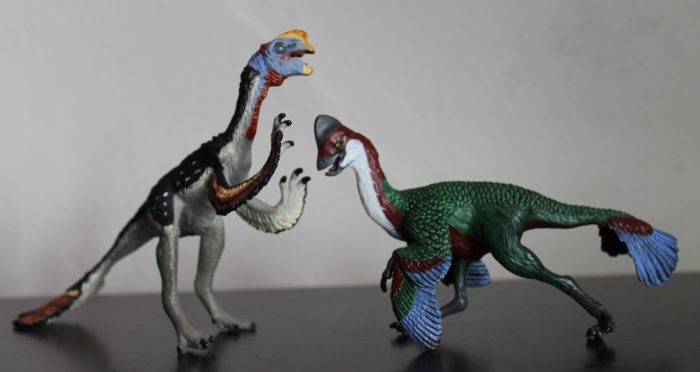
When it comes to oviraptorosaur figures I daresay that this one ranks as the best, naturally with little competition. The green back feathers I find quite distracting but otherwise I find this to be a beautiful, elegant little piece that would fit in as well in a collection of bird toys as it would non-avian dinosaurs. We’ve finally been given a proper reproduction of this fascinating dinosaur group and for fans of Anzu this may be the only option for years to come. I highly recommend the 2018 Safari Anzu, hopefully it paves the way for other oviraptorosaur figures in the future. Safari has certainly cornered the market when it comes to feathered dinosaurs.
Disclaimer: links to Ebay and Amazon on the DinoToyBlog are affiliate links, so we make a small commission if you use them. Thanks for supporting us!




I enjoy the bold, pheasant-esque color scheme of this guy- very eye catching, yet natural! It recalls all the lovely, earthy colors of a vibrant landscape. The palette also calls to mind Chris Magna’s own take on Anzu wyliei for Saurian- though, nicely, it’s nothing too close imo.
(concept art: https://chrismasna.artstation.com/projects/G2vxB?album_id=27214).
It is a complete review of this exceptional figure of Safari that by the way it seems to me that it is the only one that exists in the market together with the malawisaurus of the same company.
What I like very much about this company is the scientific rigor with which they make their figures and in this in particular I emphasize the detailedness of their pens exquisitely up to the smallest details. If you see it even with a magnifying glass you can see how cool this figure is. Another great work of a company of prehistoric animal toys and in this case of the Safari brand.
Great review. Nicely sculpted as well. The tripod pose blends in, you almost do not realize it is in one. Its nice to see that some care was put into the painting of the figure.
If the Carnegie/Safari Oviraptoroid at 5-6 feet long is indeed 1/10, as Safari asserted, does this give us about 1/20 scale for this Anzu at 11 feet in length?
Great review! I too hope we see more oviraptorosaur toys in the future. Gigantoraptor would be a prime candidate due to its size, but Citipati would be my personal preference.
First of all, I want to thank you for the work you do with the criticism.
I would like to ask you to describe the measurements with the international format (m, cm, mm …). Unlike you, the rest of the planet uses this system.
Thank you very much.
I wrote this review, not Suspsy. I’ve been writing reviews on this blog for 7 years and you’re the first person to bring this up. I can appreciate that you (and the rest of the world) use a different system of measurement but surely it is not that difficult for you to look up the conversions yourself. That’s what I have to do.